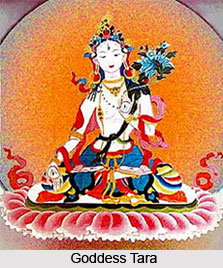 Goddess Tara gained importance in the Buddhist tradition first and later in Hindu Tradition. The earliest reference of Tara found in the Subandhu`s Vasavadatta written in the seventh century categorizes her in Buddhist context.
Goddess Tara gained importance in the Buddhist tradition first and later in Hindu Tradition. The earliest reference of Tara found in the Subandhu`s Vasavadatta written in the seventh century categorizes her in Buddhist context.
In Buddhist text and iconography goddess Tara belongs to the family of Dhyani Buddha Amoghasiddhi. She has also been related to the bodhisattva Avalokitesvara who is the family of the Dhyani Buddha Amitabha. According to legend when Avalokitesvara was about to take nirvana all the creatures of the universe began to lament. On seeing their love Avalokitesvara shed a tear of compassion for them which became goddess Tara. She is thus symbolized as the goddess of compassion. She is said to a kindhearted goddess who saves her devotes from troubles. Even her other family members Amitabha and Avalokitesvara were famous for their love and compassion towards others.
According to another legend Tara is identified with the wives of the first great Tibetan King Songsten Gampo. He is said to e an incarnation of Avalokitesvara and is Chinese wife is said to an incarnation of Green Tara and his Nepalese wife an incarnation of White Tara. Another ancient and pre Buddhist Tibetan legend mention that the people of Tibet came to existence from the union of a monkey and a rock ogress. It was in the fourteenth century that the monkey was identified as Avalokitesvara and the rock ogress as an incarnation of goddess Tara. Thus it clear the Tibetan people have always associated Tara with the origins of Tibetan people. She has been considered both as a queen as well as a mother. Tara has been referred in Tibetan Buddhism in the early eighth century when Buddhism was introduced to Tibet. The worship of Tara became widespread in the eleventh century when Atisa popularized the cult of Tara in Tibet. Atisa is said to be have experienced many divine visions of Tara. He has to his credit of translating many Sanskrit texts about Tara in Tibetan. These texts became popular can were named as Cheating Death. Another text that became popular in Tibet in the eleventh century was translated by the spiritual master Darmadra.
Goddess Tara is thus worshipped as a savior who approaches and saves the lives of her devotees who call her during dire situations. She is often said to have rescued her devotees in desperate situations and is hence known as the cheater of death. The goddess blesses her children with long life. In Tibetan monastic culture when novices are taken into ceremonies in honour of Goddess Tara, the rituals are known as `initiation into life.` The goddess is said to have several forms some of which can even be fearful and terrifying. `Homages to the Twenty-One Taras` is one of the most popular hymns sung in praise of Goddess Tara.




















